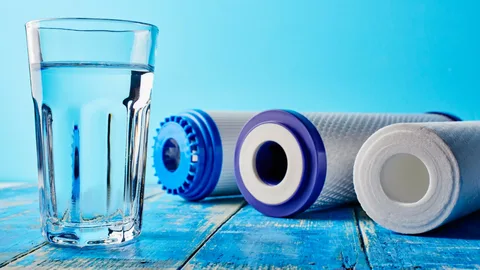
Clean water is essential for health and well-being, but achieving it isn’t always straightforward. Many people struggle with understanding the best methods to remove contaminants from their water supply. One highly effective solution is reverse osmosis, a technology designed to filter out impurities like heavy metals, chemicals, and bacteria, ensuring safe and pure water for everyday use.
In this guide we’ll provide you with the best process of cleaning and filtering water, highlight the role of reverse osmosis water filters in achieving high-quality filtration, and offer practical advice on maintaining your water filtration systems for optimal performance.
Contents
Common Methods to Clean and Filter Water
There are several ways to clean and filter water. Here are some popular techniques:
1. Boiling
Boiling water is a simple and effective method to kill bacteria, viruses, and other pathogens. However, it doesn’t remove chemical contaminants like lead or pesticides.
2. Activated Carbon Filters
Activated carbon filters can remove chlorine, odors, and certain chemicals, improving the taste of water. They are affordable and widely available, but they can’t remove heavy metals or microorganisms.
3. UV Purification Systems
UV light systems kill bacteria, viruses, and other pathogens by using ultraviolet rays. While effective at disinfection, they don’t remove other contaminants like heavy metals or pesticides.
Each method has its strengths but also limitations. Compared to these, reverse osmosis is a more comprehensive solution, as we’ll explain in the next section.
Understanding Reverse Osmosis
Reverse osmosis (RO) is one of the most effective ways to filter water, widely recognized for its ability to remove impurities. But how does it work?
How Does Reverse Osmosis Work?
Reverse osmosis uses a semipermeable membrane to filter out contaminants from water. High-pressure water is pushed through this membrane, which traps impurities and allows only clean water to pass through. The system can remove:
- Heavy metals like lead and mercury.
- Harmful chemicals such as nitrates, pesticides, and fluoride.
- Microorganisms like bacteria and viruses.
If you’re looking for a solution that can handle all these issues effectively, reverse osmosis water filters are worth exploring.
Benefits of Reverse Osmosis Systems
- High Filtration Efficiency – RO systems can remove up to 99% of impurities from water.
- Improved Taste – RO removes chlorine and other chemicals, leaving water with a fresh, clean taste.
- Cost-Effectiveness – While the upfront cost may seem high, these systems are economical in the long run compared to buying bottled water.
You can also explore a wide range of options for reverse osmosis systems and other water filtration solutions at Filpure.
How to Clean and Maintain Water Filters
To ensure your water filter works efficiently, proper cleaning and maintenance are key. Here’s a step-by-step guide:
Cleaning Sediment Filters
- Shut off the water supply and remove the filter.
- Use clean water and a brush to gently clean sediment or buildup.
- Reinstall the filter, ensuring it’s tightly secured.
Replacing Reverse Osmosis Membranes
- Check your user manual for specific replacement instructions.
- Disconnect the old membrane and attach the new one carefully.
- Flush the system with clean water before resuming use.
Signs Your Filter Needs Cleaning or Replacement
- Reduced water flow or pressure.
- Unpleasant taste or odor in the water.
- Visible dirt or sediment in the filter.
Tips for Long-term Maintenance
- Replace pre-filters every 6–12 months.
- Change RO membranes every 2–3 years, depending on usage.
- Clean other system components periodically to prevent buildup.
Everyday Uses of Reverse Osmosis
Reverse osmosis isn’t just for households—it is widely used in industries and specialized applications as well.
Household Applications
- Drinking Water – RO ensures fresh, clean water for your family.
- Cooking – Perfect for preparing food with high-quality water.
- Whole-House Systems – Some systems provide RO-filtered water for all your household needs.
Industrial Applications
- Pharmaceuticals and Laboratories – RO guarantees ultra-pure water for sensitive processes.
- Food Production – Ensures water quality for beverages and packaged foods.
Advanced Options
RO systems now offer advanced features like alkaline water filters, which balance pH levels for healthier hydration.
Comparing Reverse Osmosis with Other Methods
Here’s how reverse osmosis compares to other filtration methods:
| Filtration Method | Removes Bacteria | Removes Heavy Metals | Improves Taste | Cost-Effective Long-term |
| Boiling | ✅ | ❌ | ❌ | ✅ |
| Activated Carbon Filters | ❌ | ❌ | ✅ | ✅ |
| UV Purification | ✅ | ❌ | ❌ | ✅ |
| Reverse Osmosis | ✅ | ✅ | ✅ | ✅ |
Reverse osmosis stands out as the most versatile and reliable option of all.
Conclusions
Clean water is essential for health and quality of life, and reverse osmosis offers an effective solution for removing contaminants. By choosing the right filtration system based on your specific needs, you can enjoy better-tasting water, improved health, and long-term savings









